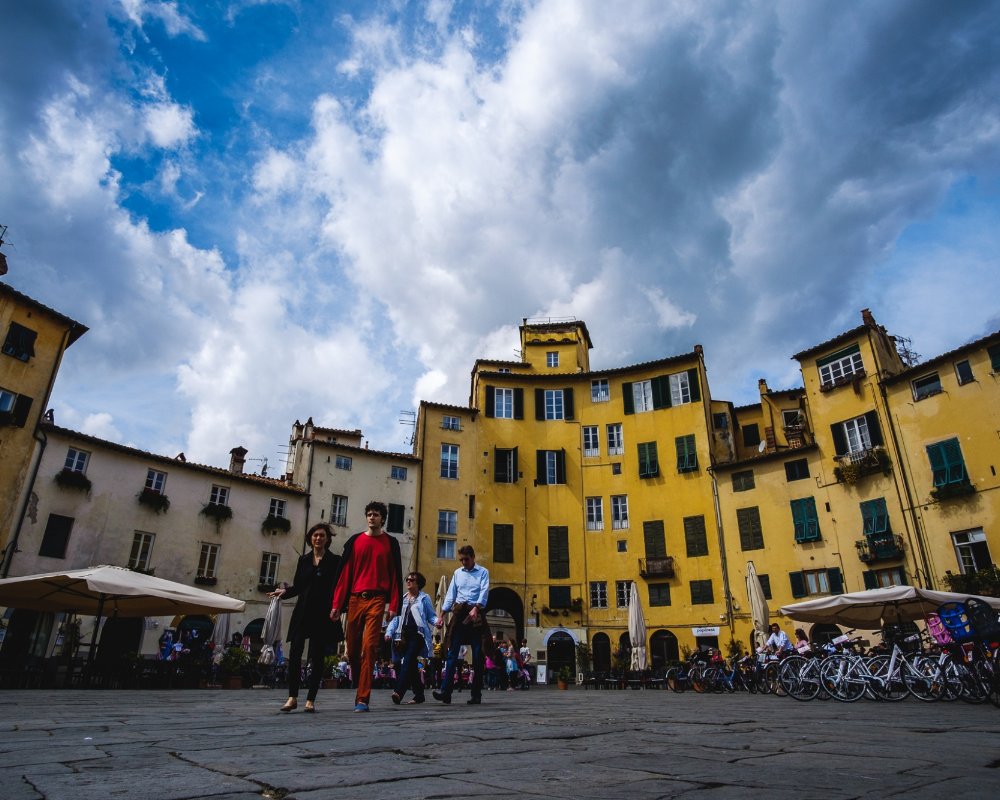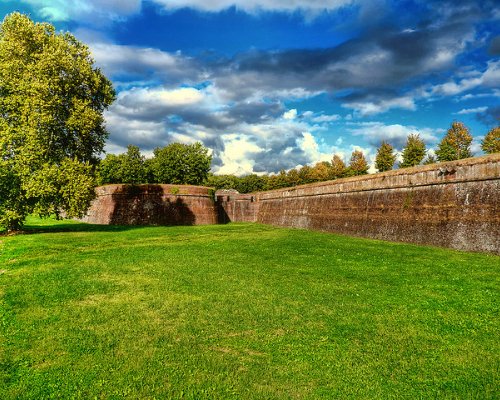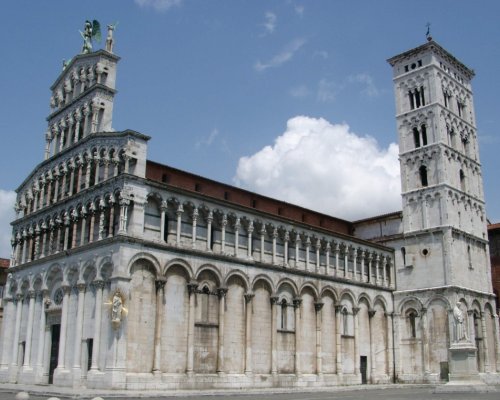Discover medieval towers, Romanesque and Gothic churches and Renaissance walls in Lucca
Any tour of Tuscany isn’t complete without a visit to this medieval gem at the foot of the Apuan Alps, just one hour from Florence. Every single corner, palace, church and monument in Lucca has a story to tell about its history, from Ancient Rome to the Middle Ages to the Napoleonic Era and the Risorgimento.
The city can be visited in just one day, but such a limited time frame wouldn’t do it justice. To discover every secret of this wonderful Tuscan jewel, two days should do the trick. Let yourself be inspired by these tips to see the city in all its glory.
This is a guest post by Valeria Pinna. Thanks Valeria!
You can start your visit from the Renaissance walls surrounding the historic city centre, still intact after all these years. There is a walking path flanked by centuries-old trees atop the walls, which can be explored on foot, by bike or on skates. From up here, you have a perfect view on one side of what awaits you below and on the other, you can admire the Apuan Alps on the horizon. What a great way to start your tour!
After visiting the walls, head to via San Paolino, one of the two main streets from the Romanesque period: the road will lead you to piazza San Michele and the namesake church with Romanesque and Gothic features, dating to the 8th century. If you look up, above its façade, you can see the 4-metre tall statue of the Michael the Archangel. If you’re lucky and the lighting is good, you can even see the diamond on his finger from a specific point in the piazza. There is sure to be a crowd of people hoping to catch a glimpse of this glittering detail!
After visiting the first of many churches you will see during your stay (Lucca is said to be "the city of 100 churches"), take via Pozzotorelli to reach Piazza Napoleone. This piazza was dedicated to Napoleon by his sister Elisa Bonaparte Baciocchi, who led the Principality of Lucca from 1805 to 1815. It has always been the centre of political power in Lucca, and even today, the Neoclassical palace (Palazzo Ducale) on the western part of the piazza is home to the province's administrative offices.
Before lunch, if you’re not starving, walk to the cathedral, another example of Romanesque and Gothic architecture, located in piazza San Martino. This piazza is also where an interesting antiques market is held every third Saturday and Sunday of the month. Among the several masterpieces inside the church, you can see the funeral monument dedicated to Ilaria del Carretto, made by Jacopo della Quercia to commemorate Paolo Guinigi's wife (an important politician who commissioned the Guinigi tower, another famous site in the city).
Lunchtime! Look for an authentic place to try local specialties: tortellini in brodo, pasta with ragù, tripe, ravioli, sausages with beans and much more... You’ll of course want to combine this delicious food with good wine. Interestingly, some restaurants allow you to pour your glass directly from a barrel. Now that you have your belly full of food and wine, you might be yearning for a nap before continuing your tour of Lucca.
You’ve already seen two of the three most important churches in Lucca. What’s the last one? That would be the Church of San Frediano! It’s the largest one after the cathedral complex. The façade is decorated with a monumental mosaic depicting Christ ascending to heaven.
To complete the afternoon, we recommend that you wander Lucca’s many narrow streets and enjoy your dinner in the beautiful piazza Anfiteatro. The piazza’s unique oval shape corresponds to an ancient arena that was once located here. Today it’s dotted with several restaurants, bar and souvenirs shops.
You can start your visit from the Renaissance walls surrounding the historic city centre, still intact after all these years. There is a walking path flanked by centuries-old trees atop the walls, which can be explored on foot, by bike or on skates. From up here, you have a perfect view on one side of what awaits you below and on the other, you can admire the Apuan Alps on the horizon. What a great way to start your tour!
After visiting the walls, head to via San Paolino, one of the two main streets from the Romanesque period: the road will lead you to piazza San Michele and the namesake church with Romanesque and Gothic features, dating to the 8th century. If you look up, above its façade, you can see the 4-metre tall statue of the Michael the Archangel. If you’re lucky and the lighting is good, you can even see the diamond on his finger from a specific point in the piazza. There is sure to be a crowd of people hoping to catch a glimpse of this glittering detail!
After visiting the first of many churches you will see during your stay (Lucca is said to be "the city of 100 churches"), take via Pozzotorelli to reach Piazza Napoleone. This piazza was dedicated to Napoleon by his sister Elisa Bonaparte Baciocchi, who led the Principality of Lucca from 1805 to 1815. It has always been the centre of political power in Lucca, and even today, the Neoclassical palace (Palazzo Ducale) on the western part of the piazza is home to the province's administrative offices.
Before lunch, if you’re not starving, walk to the cathedral, another example of Romanesque and Gothic architecture, located in piazza San Martino. This piazza is also where an interesting antiques market is held every third Saturday and Sunday of the month. Among the several masterpieces inside the church, you can see the funeral monument dedicated to Ilaria del Carretto, made by Jacopo della Quercia to commemorate Paolo Guinigi's wife (an important politician who commissioned the Guinigi tower, another famous site in the city).
Lunchtime! Look for an authentic place to try local specialties: tortellini in brodo, pasta with ragù, tripe, ravioli, sausages with beans and much more... You’ll of course want to combine this delicious food with good wine. Interestingly, some restaurants allow you to pour your glass directly from a barrel. Now that you have your belly full of food and wine, you might be yearning for a nap before continuing your tour of Lucca.
You’ve already seen two of the three most important churches in Lucca. What’s the last one? That would be the Church of San Frediano! It’s the largest one after the cathedral complex. The façade is decorated with a monumental mosaic depicting Christ ascending to heaven.
To complete the afternoon, we recommend that you wander Lucca’s many narrow streets and enjoy your dinner in the beautiful piazza Anfiteatro. The piazza’s unique oval shape corresponds to an ancient arena that was once located here. Today it’s dotted with several restaurants, bar and souvenirs shops.
Start the second day looking down at the city from above. To get these wonderful views, you’ll need to climb the two highest towers in Lucca: the Guinigi Tower and the Clock Tower. The first one is very peculiar because at the top is a small garden of holm oaks. The Clock Tower, with its 207 wooden steps, is the higher tower in Lucca; inside, you can even see the clock’s historic, manual mechanism. We recommend buying the combined ticket for the two towers, which also includes a visit to the Botanical Garden, so after those tiring climbs, you can relax in this enchanting location found just inside the city walls.
Does esotericism fascinate you? Here in Lucca there are several mysteries to be discovered. One of these is the devil's stone in Palazzo Bernardini. When the Bernardini family commissioned the palace, with the intent of demolishing the existing building, a problem emerged: there was an effigy depicting the Virgin Mary on one of the walls. According to legend, the devil himself told Bernardini not to demolish the wall but he didn't care. Still today, on the exact spot where this image once was, you can see a window with a recessed stone: unsuccessful attempts have been made to fix it, so the stone was left as is.
What do you think about taking some time for a bit of shopping? Dedicate the rest of the afternoon to visiting the amazing shops on via Fillungo, the main shopping street in Lucca. This is where you can find not only clothing stores but also many food shops that offer a huge variety of local products.
Before leaving the city, if you haven’t yet had your fill of culture, there is still one more museum to visit: the Puccini Museum, the home where the great composer was born and spent his early years training in music before moving to Milan. You can take a selfie with him – with his statue, that is! – in the delightful piazza in front of the museum.
Start the second day looking down at the city from above. To get these wonderful views, you’ll need to climb the two highest towers in Lucca: the Guinigi Tower and the Clock Tower. The first one is very peculiar because at the top is a small garden of holm oaks. The Clock Tower, with its 207 wooden steps, is the higher tower in Lucca; inside, you can even see the clock’s historic, manual mechanism. We recommend buying the combined ticket for the two towers, which also includes a visit to the Botanical Garden, so after those tiring climbs, you can relax in this enchanting location found just inside the city walls.
Does esotericism fascinate you? Here in Lucca there are several mysteries to be discovered. One of these is the devil's stone in Palazzo Bernardini. When the Bernardini family commissioned the palace, with the intent of demolishing the existing building, a problem emerged: there was an effigy depicting the Virgin Mary on one of the walls. According to legend, the devil himself told Bernardini not to demolish the wall but he didn't care. Still today, on the exact spot where this image once was, you can see a window with a recessed stone: unsuccessful attempts have been made to fix it, so the stone was left as is.
What do you think about taking some time for a bit of shopping? Dedicate the rest of the afternoon to visiting the amazing shops on via Fillungo, the main shopping street in Lucca. This is where you can find not only clothing stores but also many food shops that offer a huge variety of local products.
Before leaving the city, if you haven’t yet had your fill of culture, there is still one more museum to visit: the Puccini Museum, the home where the great composer was born and spent his early years training in music before moving to Milan. You can take a selfie with him – with his statue, that is! – in the delightful piazza in front of the museum.


